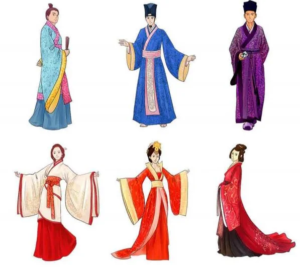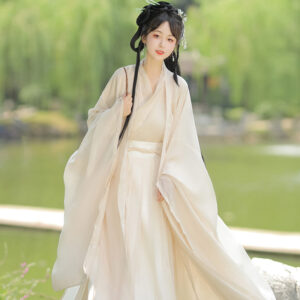

Selecting the right Hanfu for different seasons involves understanding fabric weight, layering techniques, and seasonal colors and patterns. Each season brings unique characteristics that influence the choice of materials and styles, ensuring both comfort and aesthetic appeal. The process of selecting Hanfu can be both exciting and daunting, especially with the myriad of options available in terms of designs, fabrics, and accessories. By being mindful of seasonal changes, you can curate a wardrobe that not only looks beautiful but also feels comfortable throughout the year.
Seasonal Considerations
When selecting Hanfu, it is crucial to consider the following seasonal elements:
- Spring: Lightweight fabrics such as silk and linen are ideal, featuring pastel colors and floral patterns that reflect the blooming nature around us. Spring is often associated with renewal and growth, making it an excellent time to embrace lighter fabrics that allow your skin to breathe while still looking elegant.
- Summer: Bright colors like azure and coral dominate during this vibrant season, with light embroideries that reflect the season’s vitality. Summer calls for outfits that are not only stylish but also functional; breathable materials will help you stay cool while showcasing lively patterns that capture the essence of summer festivities.
- Autumn: Heavier fabrics like wool come into play, with earth tones and subtle patterns inspired by nature’s changes as leaves transition from green to gold and red. Autumn is a time of harvest and reflection, making it an excellent opportunity to wear richer colors and textures that evoke warmth and comfort.
- Winter: Thick materials such as brocade are necessary during this cold season, complemented by deeper hues and intricate designs that convey elegance even in chilly weather. Winter Hanfu can be layered beautifully with shawls or cloaks, allowing you to maintain both style and warmth as temperatures drop.
Understanding Fabrics and Layering Techniques
Choosing the right fabric is essential in Hanfu selection because each material has its own properties that affect comfort, appearance, and durability. For spring, silk is favored due to its breathability and luxurious feel against the skin, while summer requires lighter cotton or linen blends that wick moisture away from the body. These fabrics not only enhance comfort but also allow for beautiful draping that accentuates traditional designs.Layering is a vital technique that allows adaptability throughout the day; it enables you to adjust your outfit based on changing temperatures or occasions. For instance, a lighter inner layer can be paired with a heavier outer garment during spring or autumn, providing comfort as temperatures fluctuate throughout the day. This versatility ensures you can transition seamlessly from a warm afternoon to a cooler evening without sacrificing style.
Color Palettes Across Seasons
Colors in Hanfu not only reflect personal style but also resonate with seasonal moods; they can evoke emotions and set the tone for various occasions.
- Spring: Soft pinks, gentle greens, and sky blues symbolize renewal and freshness after winter’s dormancy. These colors are often found in floral prints or delicate embroideries that celebrate the season’s vibrancy.
- Summer: Vivid shades like bright yellows and bold reds capture the energy of the season while reflecting sunlight beautifully. Summer outfits often incorporate lively patterns that celebrate outdoor gatherings, festivals, or family reunions.
- Autumn: Earthy tones such as amber, rust, and maroon echo the natural landscape as leaves change color; these shades create a warm atmosphere perfect for cozy gatherings or festive celebrations.
- Winter: Cooler colors like icy blues paired with intricate patterns symbolize serenity amidst winter’s chill; they can evoke feelings of calmness while maintaining an air of sophistication through rich textures.
Patterns and Their Significance
Patterns in Hanfu carry deep cultural meanings; they are not merely decorative but often tell stories or convey messages rooted in tradition. Floral designs are prevalent in spring and summer, representing growth, beauty, and femininity, while autumn motifs often depict harvest symbols celebrating abundance—think grains or fruits that signify prosperity.Winter designs may include geometric shapes or mythical creatures symbolizing endurance against harsh conditions; these patterns serve not only as decoration but also as reminders of resilience through challenging times. Understanding these meanings can deepen your appreciation for Hanfu as more than just clothing but as an expression of cultural identity.
Practical Tips for Each Season
Spring
- Opt for lightweight silk or linen garments that allow airflow while providing a touch of elegance.
- Incorporate detachable sleeves or layers so you can adjust your outfit based on temperature changes throughout the day.
- Choose floral patterns in pastel colors that resonate with the blossoming nature around you; these choices will enhance your connection to spring’s beauty.
Summer
- Select breathable fabrics like cotton or linen blends designed specifically for hot weather; these materials will keep you cool during summer festivities.
- Embrace bright colors that reflect sunlight—think vibrant yellows or deep blues—that will lift your mood while showcasing your personality.
- Keep embroideries light and airy; intricate yet subtle designs will add charm without overwhelming your summer look.
Autumn
- Transition into heavier fabrics like wool blends or thicker cottons designed to provide warmth without sacrificing style.
- Use earth tones that resonate with fall foliage—rich browns, burnt oranges—creating a harmonious look that reflects nature’s palette.
- Incorporate subtle patterns inspired by nature’s changes; consider motifs like leaves or acorns which celebrate autumn’s bounty.
Winter
- Choose thick materials like brocade or heavy cotton blends designed specifically for colder months; these fabrics provide insulation while looking regal.
- Favor deeper hues—think burgundy or navy—that convey warmth; these colors create an inviting atmosphere even in chilly weather.
- Layer effectively with undergarments designed for warmth; consider thermal options that maintain comfort without compromising on style.
Accessories That Complement Hanfu
Accessories play a significant role in enhancing Hanfu outfits across seasons; they can elevate your look while adding personal flair.
- Spring/Summer: Light scarves made from breathable materials or hairpins adorned with floral designs can elevate your look without adding bulk; they provide just enough detail to make your outfit pop during warmer months.
- Autumn/Winter: Consider heavier shawls or cloaks made from warm fabrics that not only provide insulation but also add elegance; accessories like embroidered gloves or hats can complete your look while keeping you cozy.
Conclusion
Selecting Hanfu according to the seasons is an art form that combines tradition with modern sensibility; it requires thoughtful consideration of various elements including fabric choice, color palettes, layering techniques, and cultural significance. By understanding these aspects deeply, one can create stunning outfits that celebrate both personal style and heritage throughout the year.Incorporating these elements ensures that your Hanfu selection remains relevant while honoring its rich cultural background. This thoughtful approach allows you to express yourself beautifully through clothing while staying comfortable across all seasons.
Share this post
Recent Posts


What were the key features of Hanfu during the Tang Dynasty?

How did Hanfu styles vary during different Chinese dynasties?

What accessories are typically worn with Hanfu?

How do you choose the right Hanfu for different seasons?

Newsletter
Popular Categories
Related Post
Sed aliquam, tortor et sodales malesuada, lorem leo luctus tellus, quis interdum eros nibh in nunc. Cras dignissim malesuada, lorem leo luctus

What are the winter hanfu called?

What were the key features of Hanfu during the Tang Dynasty?

How did Hanfu styles vary during different Chinese dynasties?


